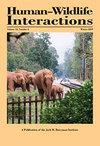北美大型鸟类数量的增加对航空安全构成了挑战
IF 0.9
4区 环境科学与生态学
Q4 BIODIVERSITY CONSERVATION
引用次数: 5
摘要
在鸟-机碰撞中,鸟的质量和飞机损坏的可能性之间有很强的相关性。因此,美国联邦航空管理局(FAA)已经建立了与发动机、机身和挡风玻璃有关的适航标准。大多数标准使用大型(1.8公斤)和中型(1.1公斤)鸟作为基准(尾翼和某些大型涡扇发动机使用3.6公斤的鸟)。1990年至2018年,北美有20种大型(≥1.8公斤)和16种中型(1.1-1.7公斤)鸟类在民用飞机上发生≥20次撞击(FAA国家野生动物撞击数据库)。我分析了这36个物种从1990年到2018年的种群变化与群集行为的关系。20种大型鸟类的总数量净增2780万只(增加129%)。对于16个中等物种,合并后的种群净增670万只(增加20%)。体重≥3.6 kg的9种种群数量均有所增加。与鸟类数量的增加一致,大型和中型鸟类的袭击次数在1990 - 2020年呈显著(P < 0.01)的上升趋势,多鸟的袭击次数也呈显著(P < 0.01)上升趋势。2018年,大中型鸟类,尤其是群居鸟类对航空安全的威胁远高于1990年。尽管通过管理项目使大中型鸟类远离机场物业,在降低风险方面取得了进展,但这些行动对减轻飞行爬升和接近阶段的威胁收效甚微。提高飞机部件的适航标准,提供实时预警的鸟类探测雷达,以及提高飞机对鸟类可见度的飞机照明方案是研究和开发的优先领域,以减轻这些机场外对航空安全的威胁。本文章由计算机程序翻译,如有差异,请以英文原文为准。
Population Increases of Large Birds in North America Pose Challenges for Aviation Safety
There is a strong correlation between bird mass and the likelihood of aircraft damage during a bird–aircraft collision. Thus, the U.S. Federal Aviation Administration (FAA) has established airworthiness standards related to bird mass for engines, airframes, and windshields. Most standards use large (1.8 kg) and medium (1.1 kg) birds as benchmarks (the empennage and certain large turbofan engines use a 3.6-kg bird). There are 20 large (≥1.8 kg) and 16 medium (1.1–1.7 kg) bird species in North America with ≥20 strikes reported for civil aircraft (FAA National Wildlife Strike Database), 1990 to 2018. I analyzed the population changes of these 36 species from 1990 to 2018 in relation to flocking behavior. For the 20 large species, the combined population had a net gain of 27.8 million birds (129% increase). For the 16 medium species, the combined population had a net gain of 6.7 million birds (20% increase). Notably, all 9 species with body mass ≥3.6 kg indicated population increases. In agreement with the increased numbers of birds, the number of strikes involving large and medium birds showed significant (P < 0.01) positive trends from 1990 to 2020 as did strikes involving multiple birds. The threat to aviation safety from large and medium birds, especially flocking species, was much higher in 2018 than in 1990. Although progress is being made to mitigate the risk by management programs to keep large and medium birds away from airport properties, these actions do little to mitigate the threat during climb and approach phases of flight. Enhanced airworthiness standards for aircraft components, bird-detecting radar to provide real-time warnings, and aircraft lighting schemes to improve visibility of aircraft to birds are priority areas of research and development to mitigate these off-airport threats to aviation safety.
求助全文
通过发布文献求助,成功后即可免费获取论文全文。
去求助
来源期刊

Human–Wildlife Interactions
Environmental Science-Nature and Landscape Conservation
CiteScore
2.80
自引率
0.00%
发文量
0
审稿时长
11 weeks
期刊介绍:
Human–Wildlife Interactions (HWI) serves the professional needs of the wildlife biologist and manager in the arena of human–wildlife conflicts/interactions, wildlife damage management, and contemporary wildlife management. The intent of HWI is to publish original contributions on all aspects of contemporary wildlife management and human–wildlife interactions with an emphasis on scientific research and management case studies that identify and report innovative conservation strategies, technologies, tools, and partnerships that can enhance human–wildlife interactions by mitigating human–wildlife conflicts through direct and indirect management of wildlife and increased stakeholder engagement. Our intent is to promote a dialogue among wildlife professionals concerning contemporary management issues. As such, we hope to provide a repository for wildlife management science and case studies that document and share manager experiences and lessons learned.
 求助内容:
求助内容: 应助结果提醒方式:
应助结果提醒方式:


